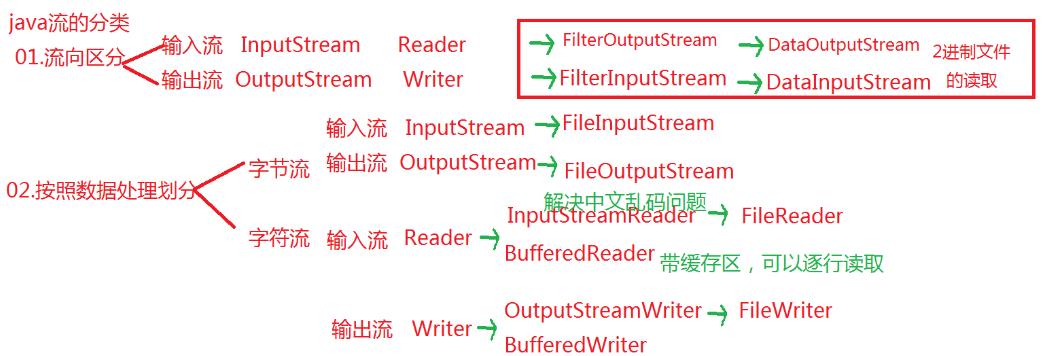IO--File
Posted 小葱拌豆腐
tags:
篇首语:本文由小常识网(cha138.com)小编为大家整理,主要介绍了IO--File相关的知识,希望对你有一定的参考价值。
1.使用File操作文件

public class IoTest { public static void main(String[] args) throws IOException { /* 01.删除或者创建文件 * File file=new File("e:/io.txt"); addOrDel(file); */ File file=new File("e:/java/hello"); //file.mkdir(); 只能创建一层目录 file.mkdirs(); //同时创建多层目录 } /** * 删除或者创建文件 */ public static void addOrDel(File file) throws IOException { if (!file.exists()) { //判断文件是否存在 if (file.createNewFile()) {//创建成功 System.out.println("创建成功!"); System.out.println("是否是文件:"+file.isFile()); System.out.println("文件名称:"+file.getName()); System.out.println("文件大小:"+file.length()); System.out.println("文件的绝对路径:"+file.getAbsolutePath()); }else { System.out.println("创建失败"); } }else { System.out.println("文件已经存在!"); if (file.delete()) {//删除文件 System.out.println("删除成功!"); } } } }
2.把自己的写好的内容 导出成jar包
01.右键选中写好的类 Export
02.输入jar,之后选中 JAR file
03.输入导出的位置以及文件名

3.使用FileInputStream读取文件内容(字节流)
package cn.bdqn.test; import java.io.FileInputStream; import java.io.FileNotFoundException; import java.io.IOException; import java.io.InputStream; /** * * @author 小豆腐 * 以后的你,会感谢现在努力的自己!努力!坚持!不放弃! * * 所有的输入流都有 读 的方法 * 所有的输出流都有 写 的方法 * * 输入输出流都是相对于计算机的内存而言 * * 字节输入流的基类是 InputStream * 字节输出流的基类是 OutputStream * * 字符输入流的基类是 Reader * 字符输出流的基类是 Writer * * * utf-8 :中文字符以及中文都是占3个字节! 数字和字母都是占1个! * GBK: 中文字符以及中文都是占2个字节! */ public class FileInputStreamTest { public static void main(String[] args) { InputStream stream = null; try { stream = new FileInputStream("e:/hello.txt"); System.out.println("可读取的字节数:" + stream.available()); int num = 0; while ((num = stream.read()) != -1) { // 出现中文乱码 因为utf-8中中文占3个字节 System.out.println((char) num); } } catch (FileNotFoundException e) { e.printStackTrace(); } catch (IOException e) { e.printStackTrace(); } finally { // 关闭流 try { stream.close(); } catch (IOException e) { e.printStackTrace(); } } } }
4.使用OutputStream写入文件内容(字节流)
package cn.bdqn.test; import java.io.FileNotFoundException; import java.io.FileOutputStream; import java.io.IOException; import java.io.OutputStream; /** * * @author 小豆腐 * 以后的你,会感谢现在努力的自己!努力!坚持!不放弃! * * 01.java项目的编码格式 要和输出文件的编码一致 都是UTF-8 * 02.如果系统中没有指定的文件,会默认创建 * 03.如果重复输出,则上次的内容会被覆盖 * 如果不想覆盖!使用重载!在第二个参数的位置输入true */ public class OutputStreamTest { public static void main(String[] args) { OutputStream stream = null; try { // stream = new FileOutputStream("e:/hello.txt"); stream = new FileOutputStream("e:/hello.txt", true); // 在原本的内容上拼接 // 这里是整体作为一个参数 stream.write("中国1".getBytes()); stream.write("中国2".getBytes()); // 强行把缓冲区的数据写到输出流中 stream.flush(); stream.write("中国3".getBytes()); } catch (FileNotFoundException e) { e.printStackTrace(); } catch (IOException e) { e.printStackTrace(); } finally { try { stream.close(); } catch (IOException e) { e.printStackTrace(); } } } }
5.使用FileReader读取文件内容(字符流)

public class FileReaderTest03 { public static void main(String[] args) throws Exception { //获取当前的编码格式 System.out.println("使用的编码为:"+System.getProperty("file.encoding")); //创建输入流 Reader Reader reader=new FileReader("e:/hello.txt"); //因为读取的字符 创建数据的中转站 会有多余的空格产生 char [] words=new char[1024]; int num; //需要字符串的 拼接 StringBuilder sb=new StringBuilder(); while((num=reader.read(words))!=-1){ sb.append(words); } System.out.println(sb.toString()); //关闭输入流 reader.close(); } }
6.使用BufferedReader读取文件内容(字符流)

public class BufferedReaderTest04 { public static void main(String[] args) { /* * 创建输入流 Reader * BufferedReader和FileReader联合使用 * 效率高 底层有默认的缓冲区 还可以逐行读取 */ //创建BufferedReader对象 传递Reader的对象 BufferedReader br=null; Reader reader=null; try { reader = new FileReader("e:/hello.txt"); br=new BufferedReader(reader); //一行一行的读取 String line=null; while((line=br.readLine())!=null){ System.out.println(line); } } catch (FileNotFoundException e) { e.printStackTrace(); } catch (IOException e) { e.printStackTrace(); }finally{ //关闭流 先开的后关 try { br.close(); reader.close(); } catch (IOException e) { e.printStackTrace(); } } } }
7.使用OutputStreamWriter写入文件(字符流)

public class OutputStreamWriterTest05 { public static void main(String[] args) { try { /* * 输出流 默认的会给我们创建新的文件 * 不使用第二个参数! 那么默认会覆盖之前的内容 * ctrl +shift +t 选中需要查询的类或者接口 */ Writer writer=new FileWriter("e:/hello.txt",true); writer.write("我爱北京天安门!"); writer.close(); } catch (IOException e) { e.printStackTrace(); } } }
8.使用BufferedWriter写入文件(字符流)

public class BufferedWriterTest06 { public static void main(String[] args) { try { //创建输出流对象 Writer writer=new FileWriter("e:/hello.txt",true); //创建BufferedWriter对象 BufferedWriter bw=new BufferedWriter(writer); //换行 bw.newLine(); bw.write("北京也爱你!"); bw.newLine(); bw.write("北京也爱你!"); bw.close(); writer.close(); //获取输入流 Reader reader=new FileReader("e:/hello.txt"); BufferedReader br=new BufferedReader(reader); String line=null; while((line=br.readLine())!=null){ System.out.println(line); } br.close(); reader.close(); } catch (IOException e) { e.printStackTrace(); } } }
9.使用InputStreamReader解决中文乱码问题

public class InputStreamReaderTest07 { public static void main(String[] args) { BufferedReader br=null; InputStreamReader isr=null; InputStream stream=null; try { //创建输入流对象 stream=new FileInputStream("e:/hello.txt"); System.out.println("文件的大小:"+stream.available()); //使用InputStreamReader来解决乱码 isr=new InputStreamReader(stream, "utf-8"); //读取 br=new BufferedReader(isr); String line=null; while((line=br.readLine())!=null){ System.out.println(line); } } catch (FileNotFoundException e) { e.printStackTrace(); } catch (UnsupportedEncodingException e) { e.printStackTrace(); } catch (IOException e) { e.printStackTrace(); }finally{ try { br.close(); isr.close(); stream.close(); } catch (IOException e) { e.printStackTrace(); } } } }
10.读取2进制文件

public class DataInputStreamTest08 { public static void main(String[] args) throws Exception { //创建输入流 InputStream fis=new FileInputStream("e:/mm.mp3"); //读取2进制文件 DataInputStream dis=new DataInputStream(fis); //复制文件到另一个目录 OutputStream fos=new FileOutputStream("e:/U1/慢慢.mp3"); //以2进制的方式输出到指定的目录 DataOutputStream dos=new DataOutputStream(fos); //开始读取 int data; while((data=dis.read())!=-1){ //写入 dos.write(data); } dos.close(); fos.close(); dis.close(); fis.close(); }
11.序列化和反序列化

/** * 序列化:将内存中对象的状态或者信息 转换成 持久化的过程! * 反序列化:把持久化的对象 变成 内存中的一个对象的过程! * 目的: * 01.使自定义的对象 持久化!对象本身是在内存中的!我们想把它持久化! * 02.把对象从一个地方传递到另一个地方! * 03.使程序具有维护性! * * 怎么才能实现对象的序列化?? * 1.让对象所属的类 实现Serializable 接口 之后, 这个类 就可以序列化了! * Serializable:只是一个能否被序列化的标记! */ public class Student implements Serializable{ //实体类 private Integer id; private Integer age; private String name; @Override public String toString() { return "Student [id=" + id + ", age=" + age + ", name=" + name + "]"; } public Student() { super(); } public Student(Integer id, Integer age, String name) { super(); this.id = id; this.age = age; this.name = name; } public Integer getId() { return id; } public void setId(Integer id) { this.id = id; } public Integer getAge() { return age; } public void setAge(Integer age) { this.age = age; } public String getName() { return name; } public void setName(String name) { this.name = name; } }

public class SerializableTest { public static void main(String[] args) throws Exception { //序列化操作 //首先实例化一个对象 Student student=new Student(1, 500, "小白2"); //想序列化?从内存中 放入 持久化的介质中 输出流 FileOutputStream fos=new FileOutputStream("e:/student.txt"); ObjectOutputStream oos=new ObjectOutputStream(fos); //开始持久化 oos.writeObject(student); oos.close(); fos.close(); } }

/** * 反序列化 * 需要和 序列化时候的包名 一致 不然 没法反序列化 */ public class StudentTest { public static void main(String[] args) throws Exception { // 从文件中把对象 拿到 内存中 输入流 FileInputStream fis = new FileInputStream("e:/student.txt"); ObjectInputStream ois = new ObjectInputStream(fis); // 读取文件中的对象 Student student = (Student) ois.readObject(); System.out.println(student.getId()); System.out.println(student.getAge()); System.out.println(student.getName()); ois.close(); fis.close(); } }

以上是关于IO--File的主要内容,如果未能解决你的问题,请参考以下文章
